Mechanical Set-up
Tires
Tires are one of the most complex element of setup. Also, they will have the most visible and dramatic effect on handling. Think about it, tires are the only part of the car touching the ground. An interesting fact is that the contact area of each tire is more or less equal to the area of your palm. So this gives you an idea of the incredible grip properties of the compounds.
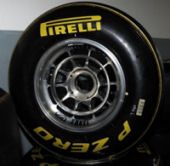 Key to good compound grip is a right tire temperature. Working temperature in Formula 1 tire is around 100 – 120ºC, depending of the track. You go to high and you have a blistering or heavy graining. To low and you don’t have any grip. Struggling to put temperature into the compound will lead to a lot of the time lost in that stint of the race. In any case, if you are a bit higher then perfect is better than if you are a bit below optimal temperature. To get it right, you have to play with car balance, camber and downforce. Getting heat into the tires is very difficult if you are missing general downforce and that comes down to the aerodynamics or general balance of the car. Sometime camber angle can help, but this have to be your last resort.
Key to good compound grip is a right tire temperature. Working temperature in Formula 1 tire is around 100 – 120ºC, depending of the track. You go to high and you have a blistering or heavy graining. To low and you don’t have any grip. Struggling to put temperature into the compound will lead to a lot of the time lost in that stint of the race. In any case, if you are a bit higher then perfect is better than if you are a bit below optimal temperature. To get it right, you have to play with car balance, camber and downforce. Getting heat into the tires is very difficult if you are missing general downforce and that comes down to the aerodynamics or general balance of the car. Sometime camber angle can help, but this have to be your last resort.
The theory of tire pressure is as follows: Higher pressures give you increased responsiveness while lower pressure, a higher maximum grip potential. As you increase the pressure, the tire becomes more rigid, thus deforms less when you turn the wheel. The contact patch stays high, and the car turns sharply. Keep increasing the pressure, and the tire contact area starts to form an "U" shape. This means that only the middle part of the tire is touching the ground, and there is a significant loss of grip and there is possibility to overheat only middle part of the tire. With higher pressure, tires will reach working temperature slower, causing bad grip in first few laps.
Lower pressure does exactly the opposite. It makes the car react more slowly. This is because of tire squirm. Squirm happens when you turn the wheel. Since the tire is slightly "loose", as the wheel turns, the contact patch tends to stay in its original position. The tire actually twists, so in front tires it will give you understeer. The flip side is that this tendency for the contact patch to remain in its current position means that you get a slight increase in road holding. Continue to reduce the pressure and the tire begins to hollow in the middle, again reducing the contact patch and reducing overall grip. With lower pressure tires will reach working temperature faster. So, compromising is the key!
Height of the body
The body height is the part of the suspension geometry setup. However, its changing is influencing aerodynamic efficiency settings. Ride height is the distance between the car and the ground. As car goes faster, the lower pressure air is passing below the car, lowering it further. So by manipulating ride height you can turn the car itself into a wing. The engineer wants a ride height to be as low as possible. There are two reasons for that. A lower car has a lower center of gravity, giving it better handling. The second is ground effects. The concept of ground effects is this: As the car passes through the air, some of it goes over the car (and onto the rear wings) while some of it goes below the car. Due to the specific shape of the underbody and diffuser, the air that travels below the car goes faster than the air above. This creates low pressure below the car, causing the higher pressure over the car to create an additional downforce. This suction causes downforce without any drag penalty. Therefore it's very, very efficient. This low-pressure downforce increases as the ride height decreases. This is why we want to run the car as low to the ground as possible without drastically affecting plank wear. Ride height is initially dictated by spring rates, which themselves are selected for handling characteristics. Then the cars ride height is fine-tuned by the ride-height adjustments on the suspension push or pull rods. Basically, you want to have front and rear ride high values as low as possible, while trying to maintain the two values as close as possible. Remember! The front ride height must always be lower than the rear ride height! Bay the way, remember Bernouly? This difference between high of front and rear end of the car is called rake angle.
And now something that connect ride height with everything else. If the aero team can create a front wing, or a rear diffuser, which is reasonably insensitive to ride height, that essentially means that you can allow the car to move up and down a lot, because the aero is not sensitive to vertical movement. This in turn means that you can soften the suspension to enable the car to run over kerbs well. If the car has to be nailed to a particular ride height because the aerodynamics fall apart if the car moves about, then you have to run very stiff springs, which means that the car clatters over kerbs and flies in the air. If you can have a car that can be run soft enough to benefit from running over kerbs to shorten the circuit, but still not lose all its downforce when running on the smooth track, then it will help lap time and you're in pretty good shape. It may seem pretty simple, but it goes some way to explaining why some updates that improve overall downforce might not actually translate in to significantly quicker lap times and why some cars are better suited to street tracks than others.
Brakes and Brake Bias
Formula 1 cars do not use power assists within the braking system. The driver requires a very high degree of "feel" fed back through the system in order for him to modulate the brakes; modulation being the minute adjustment of pressure to prevent wheel lock-up. Wheel lock-up is undesirable, however since optimum braking is the nth degree prior to lock-up, we do experience locked wheels from time to time. Especially when driving in anger! It should be noted though, increased brake system oil pressure also increases the brake wear rate. It is best to increase pressure and regulate your braking technique to decrease brake wear. This way, you can tap the full potential of the braking system at those moments when needed, such as a late braking pass.
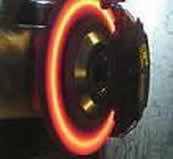 Since the performance of a Formula 1 car is based on it's ability to exploit weight transfer , it is necessary to alter the braking balance of the car. When we alter the braking balance, we're merely shifting the force of the brakes so as half the car experiences more stopping power to the wheels than the other. The half we always shift towards is the front for the simply reason that weight transfers to the front under braking. We compensate because without this shift in bias, the transfer tends to makes the rear tires less tractable.
Since the performance of a Formula 1 car is based on it's ability to exploit weight transfer , it is necessary to alter the braking balance of the car. When we alter the braking balance, we're merely shifting the force of the brakes so as half the car experiences more stopping power to the wheels than the other. The half we always shift towards is the front for the simply reason that weight transfers to the front under braking. We compensate because without this shift in bias, the transfer tends to makes the rear tires less tractable.
Brake bias is the question of purely driver preference. Before race, engineer and driver make some general decisions, but brake bias can be changed from steering wheel in some degrees during the race. Most drivers like bias to be set to 55/45 % to front wheels. As you hit the brakes, weight is transferred from the rear to the front of the car. Thus the front brakes must do more of the work. However, since the front wheels are smaller than the rear wheels, they require less force to lock up the wheels.
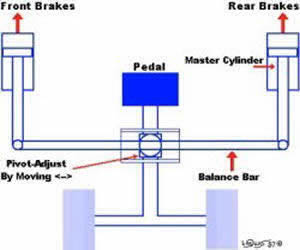 So having a brake bias to the front, means that you are setting up the car to lock front wheels before it locks the rear ones. There are many reasons for why this is desirable. The main one is that it's much easier to control a car whose front wheels are locked up. The fact that more braking power is needed at the front because weight was transferred on front tends to maximize braking potential.
So having a brake bias to the front, means that you are setting up the car to lock front wheels before it locks the rear ones. There are many reasons for why this is desirable. The main one is that it's much easier to control a car whose front wheels are locked up. The fact that more braking power is needed at the front because weight was transferred on front tends to maximize braking potential.
With 50/50 braking bias, the rear wheels will lock prematurely as the weight shifts away from them under braking causing the car to oversteer during corner entry. The reason why some drivers like bias to be set to 50/50% is because they like to brake all the way to the apex, and slightly reducing the front bias reduces the chance of the front wheels locking first. Though this tends to slightly reduce braking potential, the ability to confidently turn-in while still on the brakes is worth it.
Brakes require a certain temperature to operate at maximum efficiency. Cold brakes do not have the stopping force of a heated disc. Optimum brake temperature is around 550 °C and at this temperature the brake will produce the most amount of stopping force. However, since the stopping friction creates heat, heat then turns into a detriment, causing increased pad wear and "brake fade", or reduced stopping force.
Above 550 °C carbon brake fade begins progressively and by 1650 °C, the stopping force is half of that experienced at the optimum temperature. Running the brakes at close to their optimum temperature is crucial. Altering the brake cooling duct sizes controls this at the cost of upsetting the airflow around the car and creating drag. Inside and slightly ahead of each hub/wheel assembly, are the brakes cooling ducts. These ducts are necessary to force cool air over the brake discs. They come in several variations in size.
Gearbox
Gearboxes look complicated, but really they are quite simple. The first thing you want to do is set first gear. You take the car out to the slowest corner, and lengthen or shorten the gear so that you can take the curve flat in 1st. By that I mean, from the apex of the corner on, you can be on full power. Next you want to set your top gear. You do that by checking your revs in top gear at the fastest point of the circuit (usually it's the start/finish straight). You want to reach max revs just before the braking point. Finally, you will set the rest of the gears. You want to have decreasing gaps between gears as you move up to the top one. This is because the engine has to work harder to fight drag at higher speeds. On low downforce tracks you can have "longer" gears; high downforce tracks "shorter" ones.
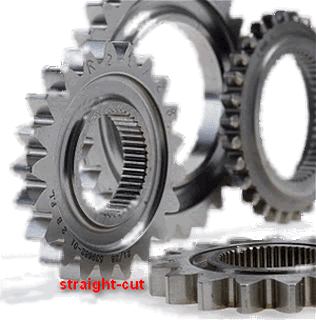 Short gears mean more power but lower acceleration, while long ones mean more top speed but lower power output. On a track like Hockenheim, where you are 100% throttle for 60 seconds per lap, acceleration isn't really important! But at Monaco, you slow down to 60-70 km/h 4-5 times per lap it is!
Short gears mean more power but lower acceleration, while long ones mean more top speed but lower power output. On a track like Hockenheim, where you are 100% throttle for 60 seconds per lap, acceleration isn't really important! But at Monaco, you slow down to 60-70 km/h 4-5 times per lap it is!
One thing to remember is that drastic change in wings setup will usually force a change in gearbox settings. The two are interconnected. Of course, procedures described before are used only at new tracks where teams racing for first time. On old tracks teams usually going to use data from previous years, with minimal modifications, if any. And another thing. For new tracks, teams are more and more using computer simulations to decide general layout of gears. Again, only minimal modifications on track are needed.
Differential/Blocking Factor (Differential Lock)
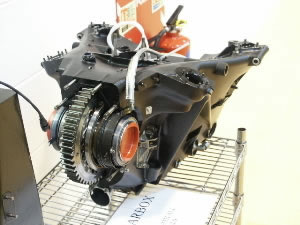 F1 differentials are of a limited slip-type.
F1 differentials are of a limited slip-type.
This is a simple setting, one that affects rear grip as well as engine power. When a car is turning, the outside wheel has a longer distance to travel than the inside wheel, thus the outside wheel must turn (rotate) faster than the inside one. When one wheel (usually the outside) begins to spin (lose grip), power is transferred from the spinning wheel to the gripping wheel. Differentials are the systems that identify this phenomenon and distribute power to the appropriate wheel. The speed at which this transfer is done is called blocking factor. A slow transfer speed means that the spinning wheel will not transfer its power suddenly, possibly causing a sudden loss of grip. Why then would you want a higher transfer speed? Because when power is transferred, there is a loss. Not all of the engine's capabilities are being transferred to the wheels. This also applies to straights. A higher blocking factor will mean a slight improvement in acceleration and top speed. Another side effect of a high blocking factor is that in low gears the wheels will spin more easily.
Camber
Camber is the vertical angle of the wheels. But let's be honest here: you will probably never use positive camber in a modern F1 racing car. If you have to use it, you have to start to think about your car. Something is fundamentally wrong whit it.
When the wheels are angled in towards the top of the car, it is called negative camber, when they open up towards the top of the car (forming a "V" shape), it is called positive camber. What is the point of camber? Camber offers two opposed benefits. Setting up the camber so that most or all of the wheel is touching the ground in the curves maximizes grip while minimizing tire wear. This is because in a curve, as the g forces load laterally, the inside side of the tire grips more than the outside side, thus it tends to heat up (and wear out). Using the telemetry to view camber along a lap, you can adjust the settings so that camber of outside wheels is zero in the turns. That will give you at once a more "stable" feel in the corner.
As you increase negative camber, you increase a force called "camber thrust". When a cambered wheel enters a corner, the tread is actually pulled sideways away from the center. This outside warping creates a counter-force, as the tire "tries" to return to its normal shape. This opposite lateral force (back towards the inside) increases road holding, giving a boost to lateral grip in a corner. This is what camber thrust is. Put on too much camber however, and not enough of the tire is making contact with the road and grip is lowered dramatically. So the ideal situation is to put on as much negative camber as tire wear allows. Another thing to realize is that you can affect the oversteer/understeer characteristics of your car by manipulating the camber. More negative camber on the front will increase oversteer, while more on the rear will increase understeer.
Wheel Alignment or Toe-ing
This setting is referred to as toe. This is the angle the wheels make with the length of the car. The reason most cars have a bit of front negative toe, or toe-in, is to promote straight-line steering stability. If a car was to have 0-degree toe it would be very nervous on a straight road, wanting to dart and wander at any little bump, rut or groove. By adding toe-in (negative toe), each wheel attempts to turn the car "inward" at all times. This in turn creates that centering feel we have through the steering wheel and promotes better straight-line stability.
If the angle opens towards the front, it's called toe out, if the angle opens to the rear, toe in. Why would you want to make the wheels unaligned? Because it modifies the response of the axle you are affecting. Toe in generally adds incisiveness in the front, and stability in the rear. Toe out reduces front responsiveness and increases the responsiveness of the rear. For example, a car that oversteers could be corrected by increasing toe-out on the front. Understeer would be corrected by increasing toe-in on the front, and perhaps increasing toe-out in the rear… If the car is losing grip coming out of corners, increasing toe in will almost always increase stability in high speed corners.
Rear toe is a highly debated topic. On the negative side, critics claim rear toe only adds to increased and uneven tire wear. And this comes with no discernable performance advantage. On the positive side, some claim that a slight positive toe, or toe-out, at the rear can help stabilize the rear of the car under acceleration.
But be mindful; too much negative toe-in will heat the outside edges of the tires, creating friction and affecting speed to a small degree. Excessive toe-out meanwhile will heat the tires inside edge. You should counter these reactions with small camber adjustments. Important thing, the more the wheels are unaligned, the more tires wear out.
Weight distribution
All Formula 1 designers attempt to deliver the car under the legal minimum weight limit
the FIA imposes. This is to allow the use of ballast to fine-tune the weight distribution of the car for a particular circuit. In fact, this is such a regular practice these days that most Formula 1 cars are delivered to the test track initially weighting less than a Formula 3 car.
Because of this, weight distribution is a sublimely difficult thing to grasp. The weight typically is adding traction to the end of the car that you shift it towards. This means that weight shifted towards the rear will put less weight on the front end resulting in increasing understeer. Shift it forward, and less weight is distributed to the rear under acceleration. Then again, it depends on how well balanced the setup is initially as it relies on spring and damper choices. So with this in mind, weight distribution is a fine adjustment of the cars handling characteristics. Typically, weight distribution is one of the final, finishing touches to a setup, and sometimes that last-ditch effort to make a stubborn car turn good. Already during the design, each car has it's own distinct weight distribution. This is due to the variations of engine weights, wheel base and chassis designs.
Shock absorbers
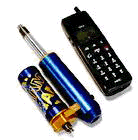 Shocks are very important to handling. Here there is no "optimal" setting for any track. It comes down to driving style and preference. Dampers don't determine a car's grip as much as they determine how much of the grip the driver can access. Each shock absorber has two settings: Compression and extension or bound and rebound. Their role is explained in their name, they "absorb" vertical energy, gathered by driving over bumps, kerbs, turning sharply at high speeds. This prevents the wheels from bouncing over bumps, losing aerodynamic efficiency as well as motive power. The compression setting refers to how hard the spring will compress over a bump. If it's hard (high value) the car is launched over a bump. However, on a flat surface, hard shocks will provide better responsiveness. As you turn into a corner, the car "rolls". The car leans over to the outside of the turn, as lateral g's are piled on. The softer the compression on the shock, the more this is true. Roll on turn-in reduces responsiveness, but it slightly improves maximum grip potential through the turn. This is also true under braking, where the car "pitches". Pitch is the effect mentioned above, when you brake, weight is transferred to the front of the car (that's why more front brake bias is used) and this also has the effect of pushing down the front and lifting the rear. Again the softer the setting, the more this is true, and the more this is true, the more braking potential is compromised. So harder shocks allow you to brake later, and with more stability.
Shocks are very important to handling. Here there is no "optimal" setting for any track. It comes down to driving style and preference. Dampers don't determine a car's grip as much as they determine how much of the grip the driver can access. Each shock absorber has two settings: Compression and extension or bound and rebound. Their role is explained in their name, they "absorb" vertical energy, gathered by driving over bumps, kerbs, turning sharply at high speeds. This prevents the wheels from bouncing over bumps, losing aerodynamic efficiency as well as motive power. The compression setting refers to how hard the spring will compress over a bump. If it's hard (high value) the car is launched over a bump. However, on a flat surface, hard shocks will provide better responsiveness. As you turn into a corner, the car "rolls". The car leans over to the outside of the turn, as lateral g's are piled on. The softer the compression on the shock, the more this is true. Roll on turn-in reduces responsiveness, but it slightly improves maximum grip potential through the turn. This is also true under braking, where the car "pitches". Pitch is the effect mentioned above, when you brake, weight is transferred to the front of the car (that's why more front brake bias is used) and this also has the effect of pushing down the front and lifting the rear. Again the softer the setting, the more this is true, and the more this is true, the more braking potential is compromised. So harder shocks allow you to brake later, and with more stability.
Extension (rebound) refers to how hard the wheel is pushed back onto the track after having been compressed. So extension helps road holding in the corners. As the car rolls or pitches, the stiffer the extension, the faster these effects are corrected. However, it is much harder to drive a car that has stiffer extension than compression. The car will tend to have massive oversteer in the corners, and will lift off coming off of kerbs or bumps. So you see that shocks offer yet another handling characteristic. Softer compression increases understeer, while stiffer extension increases oversteer. This is on turn-in, however. Once you are approaching the apex, the shocks have already done their work, and no longer have much of an effect through the corner.
Spring rates
Springs control the vertical and lateral movement of the wheels in relation to the chassis. A spring that's not stiff enough under cornering doesn't properly counteract the car's tendency to roll, moving its centre of gravity outwards and quickly overwhelming the outer tire's ability to keep a grip on the road. A spring that's too stiff slows the transfer of load from the inner to the outer tire too much; as a result, the outer tire isn't being loaded enough to achieve its potential before the corner is over. However, the spring rate that's just right for one corner on the track may be wrong for the next one, because of the corners different shape and speed. To further complicate matters, the difference front to rear must be considered as well. If the spring rate at the rear is just right, both too stiff or too-soft at the front produces understeer. If the front rate was just right, both too-stiff or too-soft at the rear produces oversteer. The driver and his engineer need to find a compromise over the many and varied corners of the track; this compromise may involve surrendering some grip from one end of the car to get the desired balance.
Packers or Bumpstops
These are elements of suspension that allow you to fine tune your spring settings. They are very hard little rubber pieces that go below the suspension damper. When the car is at high speed, the downforce presses the car down onto the ground, compressing the springs. The packers prevent the spring from compressing past a certain point, so that the car will not touch the ground at high speed and rub of the plank. When the car "bottoms out", you lose a handling and a lot of speed and downforce due to suffocation of diffuser, so they can be a great help. If you are on the packers, beware of the corners. If the springs reach the packer, it will have the effect of suddenly raising the spring stiffness dramatically. This can make cornering very difficult. It's better to use as little bump stops as you can get away with, because the handling is "unpredictable" when you relay on them too much.
Anti-Roll Bar
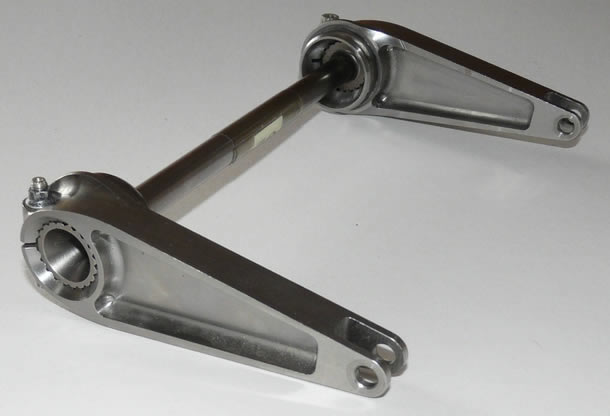
This is the same as your spring, but its effect is solely on Roll. The name pretty much explains its role. Roll bars (typical F1 roll bar on picture above) have a big effect on the car's handling, particularly in the first part of a corner as the driver turns in.
The harder the roll bar is used, the more incisive the car. Hard settings will make the axle slide a bit more through the corners, while softer means more grip. Realize then that if you have hard springs and soft roll bars, the car will feel a bit slow to respond. You will be able to brake very late, but you'll have to turn in early to make the corner. Conversely, soft springs and hard bars will make the car very good on turn in producing a little of oversteer and will tend to slide through the corners.
Let's compare two tracks that require similar springs but different roll bars. Hard springs are useful to help acceleration and braking, so let's take two tracks with long straights and hard braking: Montreal and Hokenheim. Montreal has almost no fast corners, and certainly nothing we could call a "sweeper". Hockenheim has the stadium section, as well as a few high speed corners, such as the one after the 2nd chicane, and the corner that takes us into the stadium, right after the 2nd split time marker. Since Montreal is made up of only slow or short corners, we must place emphasis on turn-in grip, so we would want harder roll bars to go along with the stiff springs. At Hockenheim, it's very useful to gain extra grip for the stadium and those corners without having to put on more wing, slowing us down on those beautiful straights. So stiff springs and softer roll bars would be preferable.
You might have noticed that the shocks seem to cover everything that the springs and roll bars do, and yes, this is true. However, you should view the shocks as a fine-tuning effect, while the springs and roll bars do most of the work. Shocks have the most influence over bumps and kerb.
Wishbone linkages
The linkage formed by the suspension arms and how they interact front to rear have a direct bearing on the overall handling characteristics of the car. The geometry of the wishbone linkages determine the roll centre of the car. The roll centre is an imaginary, but accurately defined, point on the centre-line of the car around which the car rolls on its suspension. The roll centre can be high off the ground, low, or even underneath the ground (it's only imaginary, remember). A line connecting the rear suspension roll centre with that of the front is called the roll axis. If the axis runs nose-down, the car tends to oversteer. If the axis runs nose-up, the car tends to understeer. These linkages are intrinsic to the car's design and can't be changed during a race weekend, but some adjustment can be made to the car's ride height via the suspension's pushrod. The closer to the ground, the more grip but the less the car can tolerate bumps and kerbs. The camber of the wheels can be altered by adjusting the wishbones so that the highly-loaded outer wheel becomes upright under cornering and uses more of the tire's width rather than just the outer edge. The downside of altering the camber is that it makes the car less good under braking.
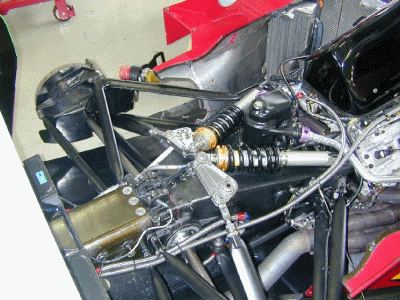
Now, to learn more about other specific parts of set-up, please follow this links:
- Set-up in general
- Set-up of aero components and their interactions
- Set-up for specific track characteristics
- Set-up for wet track
To have a complete picture of performance driving, take a look at Corners, Setup, Traction circle, Using tires, Left foot braking, braking, advanced braking, WRC braking technique, Slipstreaming, drifting, cornering, shifting, Heel and toe driving technique and steering technique articles.






